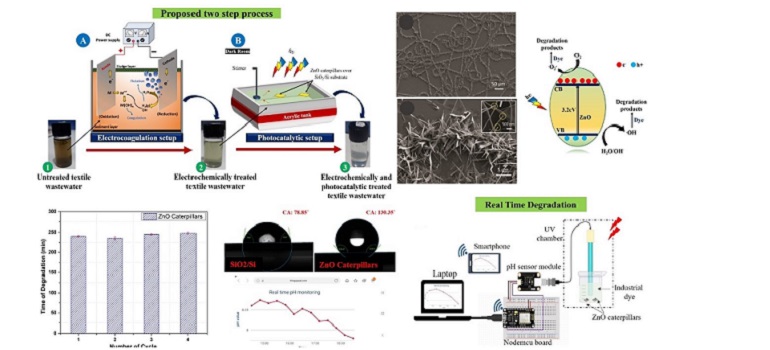The study focuses on the combination of electrochemical and photocatalytic treatment of textile wastewater using carbon nanofibers-based ZnO caterpillars
Researchers at the Indian Institute of Technology Jodhpur have developed a two-step approach for recovering textile industry-based wastewater. The process includes an electrochemical treatment in the first step, followed by real-time photocatalytic degradation using novel ZnO caterpillars grown over carbon nanofibers in the second step. This technology has several advantages, including the complete degradation of pollutants and the reduction of constraints when the two steps are applied separately, with no secondary pollution. The treated water can be used for various other purposes.
The release of synthetic dyes by the textile industry poses a danger to human and environmental health. The need for innovative treatment techniques that can result in the destruction of dye molecules in wastewater is crucial.
ALSO READ: IIT Madras employs Solar Thermal Energy to recycle waste concrete
Dr. Ankur Gupta, Assistant Professor of the Department of Mechanical Engineering at IIT Jodhpur, along with his research scholars Mr. Gulshan Verma and Mr. Prince Kumar Rai, and Prof. Jan Gerrit Korvink and Dr. Monsur Islam from the Karlsruhe Institute of Technology, Germany, have discovered this two-step process for treating textile wastewater before it is discharged into natural water bodies.
The findings were published in Materials Science and Engineering Journal (https://doi.org/10.1016/j.mseb.2022.116078).
Talking about the need of the research, Dr. Ankur Gupta, Assistant Professor, Department of Mechanical Engineering, IIT Jodhpur, said, “We need to think about recycling the wastewater & reusing the water wherever possible.”
There is an escalating need to address the problem associated with the contaminated water which is the consequence of a huge number of steel and textile industries that release a large amount of polluted wastewater. Degradable organics, heavy metals, dyes, surfactants, and pH-controlled chemicals are among the contaminants found in textile effluents (TEs). Textile industries, as one of the major consumers of water resources, produce wastewater with complex compositions, including toxic compounds, turbidity, high color, inorganic and organic compounds. In general, the type and quality of TEs (reactive dyes) used to produce complex wastewater with a high risk of contamination and coloration. Most of the conventional procedures (precipitation, ion exchange, membrane filtering, etc.) are proving ineffective due to the wide variation in the composition of textile wastewater. Therefore, there is a need for an alternate solution to overcome this problem.
The uniqueness of the research and its salient features are as follows:
- The integrated process provides the high organic matter removal efficiency with better reduction of harsh colours present in the real textile samples.
- A facile fabrication approach is used to produce ZnO caterpillars outgrown over carbon nanofibers on Si substrate using the vapor-liquid-solid method.
- A real time textile wastewater degradation is monitored using the IoT technique by integrating a NodeMCU microcontroller board and a pH sensor.
The photo-catalytic decolorization process takes ~240 min to transform the greenish yellow textile effluent to colourless (~99.1%). Additionally, significant amounts of TSS (~75%) and TDS (~80%) were removed from textile wastewater with integration of electrochemical and photocatalytic degradation processes. Further, the hydrophobic nature (CA:130.35̊) of the fabricated ZnO caterpillars and electrochemical processing together has opened a new avenue for exploring and further utilizing for industrial wastewater treatment. As per the researchers the laboratory-based proof-of-concept can be scaled up to process industrial released effluents and remediate wastewater.


